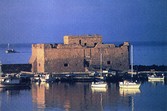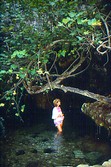 |
Pafos District Archaeological Museum | |
| Griva Digeni 43. Attractive collection of Cypriot antiquities-Neolithic Age to 1700 A.D. Mon-Fri: 07:30-17:00; Thurs: 15:00-18:00; Sat-Sun: 10:00-13:00 | ||
 |
Byzantine Museum | |
| A. Ioannou 7. Icons from the 12th to 18th centuries. Mon-Sat: 09:00-12:30; Mon-Fri: 14:00-17:00. (June to September) 16:00-19:00 | ||
| Ethnographical Museum | ||
| Exo Vrysis 1. From the Neolithic Age to the present day. Mon-Sat: 09:00-13:00; Mon-Fri: 14:00-17:00 (May to September) 15:00-19:00; Sun: 10:00-13:00 | ||
 |
Tombs of the Kings | |
| Kato Pafos. These impressive underground tombs date back to the 4th century B.C. They are carved out of solid rock, some decorated with Doric pillars. The magnificence of the tombs gives the locality its name. Mon-Sun: 07:30-17:00 | ||
| Agia Solomoni Church | ||
| Kato Pafos, Leoforos Agiou Pavlou. Originally a Christian catacomb retaining 12th-century frescoes. A sacred tree is believed to cure the sick. | ||
 |
The Mosaics of Pafos | |
| Kato Pafos, near the harbor. The mosaic floors are considered among the finest in the Eastern Mediterranean. They mainly depict scenes from Greek mythology. Mon-Sun: 07:30-17:00 | ||
| Pafos Odeon | ||
| Kato Pafos. A 2nd-century odeon built of limestone. Now used in the summer for music and theater. Nearby, the remains of ancient city walls and the Roman Agora. | ||
 |
Saranta Kolones | |
| Kato Pafos, near the harbor. Built by the Lusignans in the 13th century on the site of a previous Byzantine castle. It was destroyed by an earthquake in 1222. | ||
 |
Pafos Medieval Fort | |
| Kato Pafos harbor. A Byzantine fort built to protect the harbor. Rebuilt by the Lusignans. Dismantled by the Venetians in 1570 and rebuilt by the Ottomans in the 16th century. Mon-Sun: 10:00-17:00 | ||
 |
Panagia Chrysopolitissa Church | |
| Kato Pafos. Built in the 13th century over the ruins of the largest early-Byzantine basilica on the island. Within the compound one can see St. Paul’s Pillar, where according to tradition Saint Paul was flogged, before the Roman Governor Sergius Paulus was converted to Christianity. | ||
| Geroskipou Folk Art Museum | ||
| Geroskipou village, 3 km east of Pafos. Named after the sacred garden of Aphrodite. Folk arts and crafts is exhibited in the beautiful Chatzismith house. Mon-Fri: 07:30-14:30; Thurs: 15:00-18:00 (except July and August) | ||
 |
Agia Paraskevi Church | |
| Geroskipou village, 3 km east of Pafos. Byzantine church dating to the 10th century, a basilica surmounted by five domes forming a cross, with beautiful 15th century-murals. | ||
 |
Sanctuary of Aphrodite | |
| Kouklia village, 14 km east of Pafos, off the Lemesos-Pafos Road. Palaipaphos, Old Paphos, was a celebrated pilgrimage center of the ancient Greek world. Here stood the Sanctuary of Aphrodite, which dates back to the 12th century B.C. Daily: 07:30-17:00 | ||
 |
Petra Tou Romiou (Aphrodite’s Rock) | |
| Birthplace of Aphrodite. 25 km east of Pafos. Legend dictates that Aphrodite, goddess of love and beauty, rose from the waves in this strikingly beautiful spot. The Greek name, Petra tou Romiou or ‘The Rock of the Greek’ is associated with the legendary Byzantian frontier-guard, Digenis Akritas. | ||
| Lempa | ||
| 5 km from Pafos. At Lempa village excavations have brought to light an important settlement of the Chalcolithic period. Near the site replicas of two houses have been constructed. | ||
| Pegeia | ||
| Pegeia village, 19 km northwest of Pafos. Agios Georgios Basilica and the fountains of Pegeia. 4,5 km from the village are the ruins of two early Christian basilicas with mosaic floors. Pegeia Village is famous for its fountains in the stone-paved village square. | ||
 |
Agios Neofytos Monastery | |
| 9 km north of Pafos. Founded at the end of the 12th century by the Cypriot hermit and writer Neofytos. The ‘Egkleistra,’ an enclosure carved out of the mountain, contains some of the finest Byzantine frescoes dating from the 12th to 15th century. In the monastery’s church there is an interesting ecclesiastical museum. | ||
 |
Chrysorrogiatissa Monastery | |
| 40 km northeast of Pafos. The monastery, originally founded in the 12th century A.D., is dedicated to ‘Our Lady of the Golden Pomegranate’. The building dates back to 1770 and has a collection of important icons and treasures. Religious celebrations are held on the 15th of August. The old winery produces some of the best vintage wine of Cyprus. | ||
| Pano Panagia | ||
| On the west of Troodos 1.5 km from Chrysorrogiatissa Monastery. The birthplace of Archbishop Makarios III, first President of Cyprus. The house where he was born has been converted into a museum. | ||
| Polis | ||
| 37 km north of Pafos. Polis tis Chrysochou lies where there once stood the ancient city-kingdom of Marion. Its beautiful climate, crystal clear beaches and breathtaking scenery have made the area an attractive popular resort. | ||
 |
Baths of Aphrodite | |
| Akamas Peninsula, near Polis, 48 km north of Pafos. According to legend, the goddess Aphrodite used to take her beauty baths in a pool of a natural grotto, shaded by a fig tree, which can still be visited. Nature trails set off from Akamas to lead nature lovers to incomparable views of unspoiled land. | ||